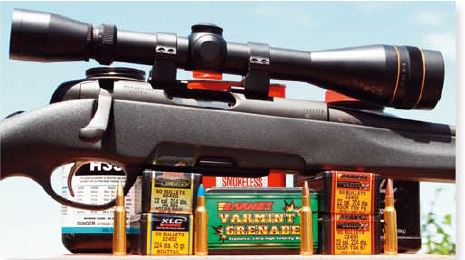
The first small caliber centerfire rifle I ever bought was a Winchester, heavy-barreled varmint model, chambered in .222 Remington. Back over forty years ago, it cost just over $ 200 at full retail! I had to go in with my brother for the purchase, as including a Leupold 12-power scope, we had over $350 into the entire package. In the olden days, we were thrilled to shoot a 1”, 3-shot group at 100 yards- things have gotten a little better four decades later. Since then, I have taken thousands of varmints and pests with the smaller .22 caliber centerfires.
In 1996, while spending 4 months in Zimbabwe, for fun I brought along a Winchester sporter in .223 Remington. On the Dark Continent, I was able to do some very interesting things using traditional varmint bullets and some of the Barnes X-Bullets, taking both pests and smaller big game, with appropriate bullets of course. As things have indeed gotten much better, both in terms of accuracy and bullet performance, I decided to take a new look at specialized loads for the .222. My desire was to develop suitable loads for pests and varmints, foxes, or coyotes, and also light big game.
Chapter 1: One Gun- Two Goals
Click to LOAD DATA SHEET
In late 2003, I was one of over a dozen writers hosted by Steyr at the unveiling of the new Ultra-Light rifle for a Tyrolean Alps marmot hunt. Having already taken thousands of pests in Montana with a .22 centerfire, I called ahead to see at what ranges we might be shooting and what type of ammunition would be provided.
The guns were to be supplied with 50 grain factory ammunition and ranges could be “from near… to far.” Not wanting to damage my small trophy, I brought along some handloads loaded with the then-new Barnes 40 grain Varminator bullets, knowing the lighter weight would be less likely to exit and cause damage to the beautiful marmot pelt.
My guess proved to be spot on, for when my chance came at around 130 yards; I placed the light bullet diagonally into the right shoulder of an old, graying male. It rolled just a short distance and lay motionless after the shot. My guide, Robert, and I, could hardly even find a mark on the beautifully, multi-colored pelt. In fact, it took a while...
to find the tiny entry hole, dead center on the right shoulder. The light bullet had cleanly done its job!
Back at the chalet, every other successful hunter was bemoaning the size of the hole in the off side of their trophies' pelts; running from golf ball to tennis ball in size. In fact, my marmot was used by most of them to take their own “success” photos due to is perfect hide. A little knowledge up ahead, can go a very long way towards having a successful outcome!
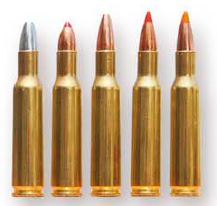
On my African adventure, I brought along 53 grain Barnes X-Bullets, loaded to around 3,300 fps in the .223 Remington. First, large baboons were taken and then finally small big game. The clincher for me was a very nice male impala. At around 175 yards, I placed a single 53 grain X diagonally through the chest from the rear with the bullet exiting through the shoulder blade on the off-side. At the site where he stood at the shot, we found spatters of blood on a broad leafed bush, and within them, small pieces of lung tissue. I still have the hide from that trophy, proving to me that with the right loads, .22 centerfires are indeed suitable for light big game.
Determined to see how bullet performance has improved since then, I gathered up good candidates for high velocity, fast expanding bullets, as well as deeper penetrating slugs designed to reliably take smaller big game. Also included was one solid, non-expanding projectile. My “marmot loads” began with the very interesting 30 grain Calhoon double hollow point, Hornady V-Maxes in 35 and 40 grains, the lead-free Barnes 36 grain Varmint Grenade, and the 40 grain Nosler Ballistic Tip.
For deeper penetrating big game loads, selections were limited to the very few projectiles specifically designed for that purpose. Nosler 60 grain Partitions in .22 caliber are made just like the big-game world famous Partitions which have been cleanly taking game for decades but in a size more appropriate for light big game. From Barnes, I used Xs in two versions and three weights: the 45 grain XLC (or now the TSX), the 53 grain TSX, and the 62 grain TSX.
My Steyr ProHunter, with its one turn in 9” twist, would not stabilize...
their very long 70 grain TSX, which the box clearly states, but I still had to prove it to myself just the same. All their lighter Xs shot very well from the Steyr. Additionally, I included the 45 grain Solid, as some hunters prefer non-expanding bullets in certain applications which do not destroy small game.
The ProHunter wore a Leupold VX-III in 6-18 power, which at the time was my standard scope for accuracy testing even on much larger caliber rifles. As this scope has seen thousands and thousands of rounds through it with nary a hiccup, I knew it would be very capable for this assignment. Only Remington brass was used- and Federal small rifle match primers. Traditional jacketed bullets were seated 0.010” off of the lands; Barnes solid and X bullets were seated 0.035” off of the lands, per their recommendation. Results were obtained by shooting at least three, three-shot groups at 100 yards with each listed load. All bullets were tried with six to eight different powders; only the good shooting loads are listed.
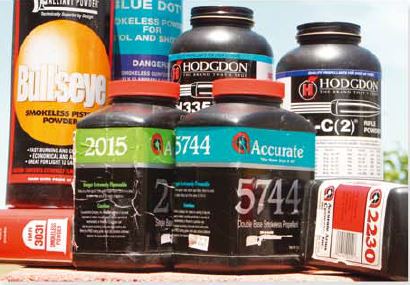
Chapter 2: Fast, Light and Explosive
Explosive does not mean that your target will disappear in a red mist…only that the bullet will be very fast to expand and breakup, once inside. With manufacturing technology today, every .22 varmint bullet will indeed breakup almost on contact. Why my handloads on the marmot were a success in preserving the trophy was because I purposefully limited the mass of the bullet in order to limit the internal distance the explosive expansion could reach.
The 50 grain bullets the other writers used were not overly expansive, just too heavy for preserving the off side of the hide on a relatively small animal. That’s why, for this testing, I started at 30 grains and stopped at only 40. I only wanted to perform load development on bullets that wouldn’t have enough mass to exit a fox or coyote.
How does almost 3,950 fps sound from a 222 Remington? Pretty amazing! Shooting into 0.83”, the short and light Calhoon double hollow point bullet should do a great job on a marmot, or even a fox out to 200 yards or so. I regularly use this bullet loaded in a Ruger Hornet at...
‘only’ 3,200 fps for prairie dogs out to 200 yards. A little more speed from the .222 using IMR 4198 should result in very good performance on even heavier targets.
Calhoon lists what he calls “gopher loads” for the .223 using his lighter .22 bullets and Alliant Blue Dot powder. I’ve tried them with very good results on paper and in the field where large volume shooting doesn’t heat the barrel or have the blast full charges of much slower burning powders generate. It is a great combination, so I experimented further with many of the assembled bullets. The results are listed throughout the loading chart.
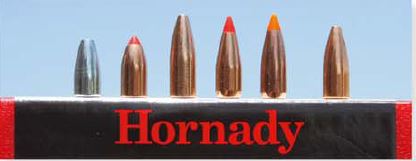
Calhoon lists what he calls “gopher loads” for the .223 using his lighter .22 bullets and Alliant Blue Dot powder. I’ve tried them with very good results on paper and in the field where large volume shooting doesn’t heat the barrel or have the blast full charges of much slower burning powders generate. It is a great combination, so I experimented further with many of the assembled bullets. The results are listed throughout the loading chart.
The 35 grain Hornady V-Max, meant for the Hornet case, provided good accuracy with Hodgdon H322 at speeds of 3,739. Slightly less accurate in my rifle, almost as fast, but much quieter shooting, 14.9 grains of Blue Dot would be great for shooting in rural areas or on farms.
How about a bullet that expands very quickly, can be shot very fast, but contains no lead at all- how can that be? Barnes is at the cutting edge of technology with their .224 caliber, 36 grain Varmint Grenade. Originally developed for special military applications, it uses powdered metal technology to combine copper and tin dust under pressure for the bullet’s core, dropping this into a conventional, internally scored thin jacket. The result? Check out their webpage for high-speed video to see a bullet totally fragmenting on only a seedless grape!
The design has been tested down as low as 1,500 fps, with explosive breakup still occurring. Needless to say, ricochets are virtually eliminated. It would be an excellent projectile on foxes or coyotes, eliminating the possibility of offside pelt damage. They shot...
into 0.59 and 0.39”, using Blue Dot and Accurate 2230 powders, at speeds of 3,600 and beyond.
Four different powders- Accurate 5744, Blue Dot, Hodgdon’s H4227, and H322 were outstanding with the 40 grain Hornady V-max bullets shooting into 0.39 ~ 0.52” at 100 yards. Velocities ran from 3,150 to almost 3,700 fps. Somewhere in there is probably a load that would shoot great in your rifle!
Only three grains of Bullseye gave me 1,284 fps, with 0.39” accuracy at 50 yards.
The last ‘explosive’ bullet type tested was the Nosler 40 grain Ballistic Tip. This was the very first type of projectile to make use of tiny, pointy plastic tips seated over hollow points to boost downrange performance, while also extending the distance at which dramatic expansion still occurs. While it shot well using 5744, or H322, and H335, it liked the listed soft speaking Blue Dot load, and really loved Accurate 2015. Nosler lists it as the accuracy powder in their manual. I would tend to agree, as my ProHunter rewarded me with quarter-inch average, 3-shot groups!
Chapter 3: MELs for the 222
It was quickly apparent that the sporter-weight production rifle I was using was capable of shooting some very small groups, including the mid-charge Blue Dot loads. So I began to wonder if the MELs concept (Moderate, Effective Loads) could work for duplicating the .22 Long Rifle, .22 Magnum, and the Hornet. The answer is a HUGE yes!
For this series, I first ran the possibilities through the QuickLOAD ballistic reloading program. Only three grains of Bullseye gave me 1,284 fps, with 0.39” accuracy at 50 yards. Four grains shot just as well but was 320 fps faster. Five grains gave me 0.35” groups at .22 Magnum speeds. With six grains, the load leaves the Magnum in the dust, shoots very well, and can be loaded for much less than the cost of the rimfire ammunition.
Only seven grains approximated standard Hornet velocities, while the top charge would surpass most every Hornet load for speed, while shooting into less than a half-inch at 100 yards! It’s so quiet (as are the lesser loads) that its use in rural areas would find great acceptance by landowners willing to let you hunt. Importantly, do not exceed the top listed load…and don’t use this data with any other bullet except the lighter 30 grain Calhoon, nor...
with any other powder.
I found that the first three loads must have the muzzle elevated, and then slowly lowered, to obtain consistent velocities and grouping, while the six to eight grain loads were not at all sensitive to powder position in the case. If you have an accurate .222, you may also be rewarded with excellent groups with several of these loads.
The last thing you absolutely must do is drop these small charges into a powder scale pan. Then deposit them directly from the scale into a primed case, and immediately seat the bullet. This is the only way to ensure you NEVER double charge a case. By following this simple procedure, you can have safe and effective special loads for your rifle, which can greatly increase its versatility.
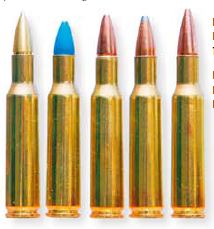
Chapter 4: Big Gam” 22 caliber Bullets
“Big game” is a relative term. We can hunt elephant by chest shooting them with a .458-500 grain Barnes X-Bullet, an eland with a .375-300 Nosler Partition, an elk with a Hornady .308-180 grain SST, or a pronghorn with just about any 100 grain bullet in the .243 Winchester…why could you not use a Barnes TSX or Nosler Partition in the .222 for the smallest of big game? Remember my impala and the 53 grain X-Bullet? Of course, a smaller caliber big game bullet will work just fine on light big game. While you do need to check local regulations before hunting with these loads, rest assured you don’t need to worry at all whether they are up to the task- they are.
The 45 grain Barnes X has taken tons of light game in Africa in the lowly little Hornet, so it’ll work very well, of course, in the 222 Remington. Hodgdon’s H322 gave good groups at just over 3,300 fps. Two particularly useful loads in rural areas, or for professional hunters having to take much game out of one area, make use of light charges of faster burning powders. Either load I tested, using 5744 or Blue Dot, had minimal recoil and muzzle blast. Landowners will appreciate such soft spoken ammunition, as will their neighbors. They both also possess minimal muzzle flash in low light conditions, another plus.
With the 53 grain Barnes TSX, great accuracy was...
achieved with Accurate 2460 and H335. Again, the Blue Dot load merits consideration in special hunting conditions. Remembering the impala taken at 175 yards and the penetration it gave, the hunter needs to be mindful of what may be behind game taken with this bullet. One powder, BL-C2 gave good results with the Nosler 60 grain Partition in the 222. However, I found that IMR 3031 was truly outstanding with this bullet, delivering over 3,200 fps, grouping right at a half-inch! The box of the Barnes long 62 grain TSXs clearly states, “Recommended Twist- 1:7” to 1:9”. My Steyr’s 1 in 9” barrel did very well with BL-C2, for almost 2,850 fps.
Shooters now have a lot of new loads to choose from if they’re seeking accuracy loads for their .222 Remington rifle.
Tim Janzen, Barnes’ R&D Engineer, stated that owners of rifle with slower twists should stay with their 45 or 53 grain X-Bullets. Even though the 70 grain TSX requires a one in eight or faster twist, I did have to prove it to myself. And yes, the slower twist of my rifle didn’t stabilize the bullets at the speeds to which I could drive them. That still leaves the hunter of smaller big game with the 45 or 53 grain Barnes bullets and the 60 Nosler Partition to work with, if the rifle has a traditional twist rate and additionally allows faster twist barrels, to try the 62 grain TSX.
Chapter 5: Summary
Shooters now have a lot of new loads to choose from if they’re seeking accuracy loads for their .222 Remington rifle. Hunters of small game, foxes, or coyotes now have many loads they can try that will not destroy the pelts of their game. Hunters are finally able to choose from several excellent loads, should they want to take smaller big game with their .222. Both the special types of loads, making use of the quiet and low recoiling Blue Dot recipes, or the MELs loaded with Bullseye, open up many interesting shooting avenues to try in your rifle.
I really liked the 222 Remington 40 years ago when I started playing with my first one. These new loads now add great versatility and power to an inherently accurate, small bore cartridge.